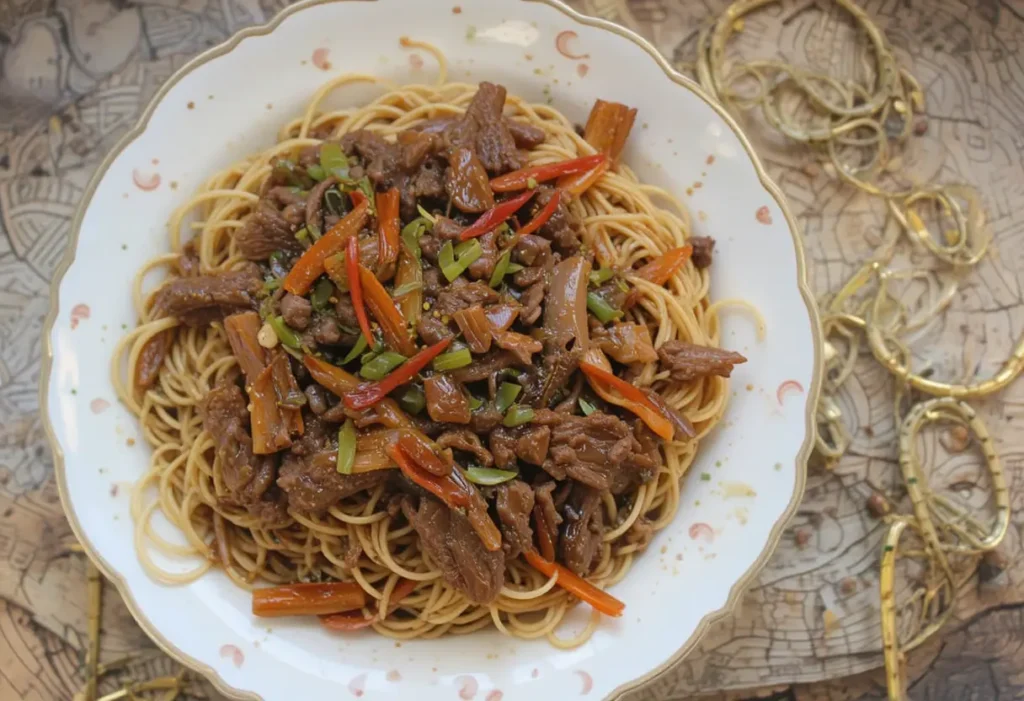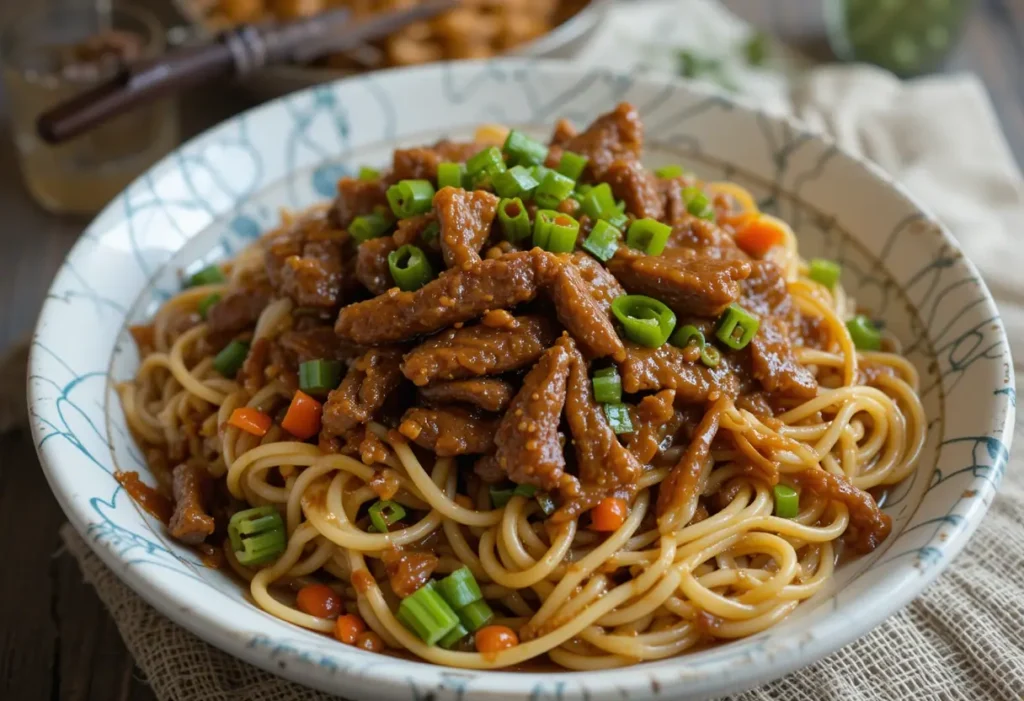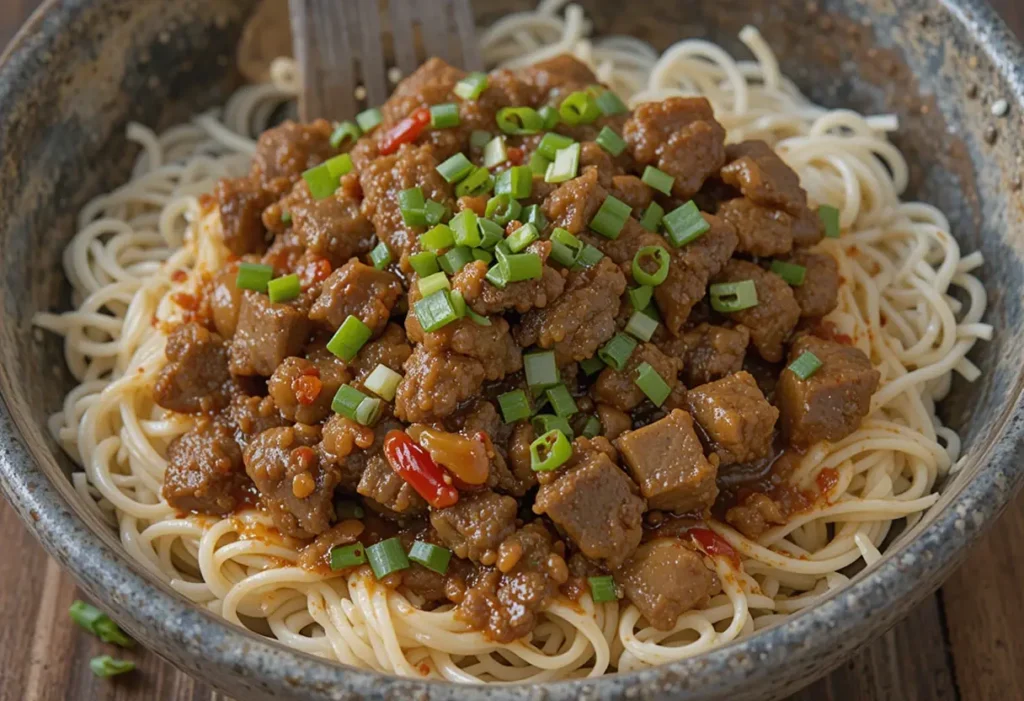A Flavorful Fusion You’ll Love
If you’re craving a dish that’s savory, sweet, and satisfyingly hearty, look no further than Mongolian Beef Noodles. This crowd-pleaser combines tender beef, perfectly cooked noodles, and a rich, umami-packed sauce that hits all the right notes. Whether you’re looking for a quick weeknight meal or something to impress guests, this dish has got you covered.
But what exactly makes Mongolian Beef Noodles so special? Let’s dive into the history, ingredients, and cooking techniques that make this dish a must-try.
What Are Mongolian Beef Noodles?
Mongolian Beef Noodles is a fusion of traditional Mongolian beef flavors with the comforting texture of noodles. While the dish itself isn’t directly from Mongolia, it draws inspiration from the region’s hearty, meat-centric cuisine. The origins of Mongolian beef are more aligned with American-Chinese cuisine, where sweet and savory sauces became popular staples in takeout menus.
Curious about the roots of Mongolian cuisine? Learn about the rich history of Mongolian cuisine to get a deeper understanding of its culinary traditions.
What Makes Mongolian Beef Unique?
The beauty of this dish lies in its bold flavors and simple preparation. Discover what makes Mongolian beef unique and why it stands out among other Asian-inspired dishes:
- Sweet and Savory Balance: The sauce perfectly blends soy sauce, brown sugar, and hoisin for a rich, caramelized flavor.
- Quick Cooking Method: Stir-frying the beef ensures it stays tender while absorbing all the flavors.
- Versatility: You can easily customize this dish with different proteins, vegetables, and spice levels.
Where Did Mongolian Beef Noodles Come From?
Though it carries the name “Mongolian,” this dish’s origins might surprise you. Learn about the origins of Mongolian Beef Noodles and how this fusion dish gained popularity across the globe.
- American-Chinese Influence: The dish was popularized in the U.S., combining Asian flavors with Western cooking techniques.
- Fusion of Cultures: The addition of noodles creates a hearty, comforting meal that appeals to a wide range of tastes.
- Restaurant Staple: Today, it’s a common menu item at many Chinese-American restaurants.

Ingredients Overview
The beauty of Mongolian Beef Noodles lies in its simplicity. Here’s what you’ll need:
- Beef: Flank steak, sirloin, or even ground beef can work. Thin slices ensure tenderness.
- Noodles: Lo mein, udon, or rice noodles are great choices. Explore different types of Asian noodles to find your perfect match.
- Sauces & Spices:
- Soy sauce for saltiness
- Hoisin sauce for a rich, sweet depth
- Brown sugar for caramelization
- Garlic and ginger for an aromatic punch
- Red pepper flakes for heat (optional)
- Sesame oil for that signature nutty flavor
- Vegetables (Optional): Bell peppers, scallions, or snap peas for added crunch and color.
Want to know more about the noodles? Find out what Mongolian noodles are made of to better understand the ingredients in this dish.
Choosing the Right Noodles
Noodles are the backbone of this dish, and selecting the right type can elevate your meal:
- Lo Mein: Thick and chewy, perfect for soaking up the sauce.
- Udon: Soft, plump noodles that add a delightful texture.
- Rice Noodles: Light and gluten-free, ideal for dietary restrictions.
For the best results:
- Fresh noodles tend to have a chewier texture, while dried noodles offer convenience and longer shelf life.
- Avoid overcooking to prevent sogginess—al dente is key.
Selecting the Best Beef
The beef should be tender and flavorful. Here’s how to get it right:
- Best Cuts:
- Flank steak: Lean and flavorful.
- Sirloin: A bit pricier but incredibly tender.
- Ground beef: A quicker, more budget-friendly option.
- Preparation Tips:
- Slice against the grain for maximum tenderness.
- Marinate in soy sauce, cornstarch, and a splash of sesame oil to enhance flavor and texture.
Curious about the history of this staple ingredient? Uncover the history behind Mongolian beef and its evolution into various delicious recipes.
Step-by-Step Recipe Guide
Ready to cook? Follow these simple steps to make the perfect Mongolian Beef Noodles:
- Cook the Noodles: Follow the package instructions, drain, and set aside.
- Prepare the Beef:
- Slice thinly or brown the ground beef in a skillet over medium-high heat.
- Make the Sauce:
- In a bowl, mix soy sauce, hoisin, brown sugar, ginger, garlic, and red pepper flakes.
- Stir-Fry:
- Add the sauce to the beef and stir until it thickens.
- Toss in the noodles and mix until well-coated.
- Serve & Garnish:
- Top with chopped scallions, sesame seeds, or a drizzle of sesame oil.
Popular Variations of Mongolian Beef Noodles
Want to mix things up? Here are some tasty variations:
- Spicy Mongolian Beef Noodles: Add extra red pepper flakes or sriracha for a fiery kick.
- Mongolian Beef Ramen: Swap out the traditional noodles for ramen to add a unique twist.
- Vegetarian/Vegan Version: Use tofu or tempeh and opt for tamari in place of soy sauce.
- Gluten-Free Adaptation: Use gluten-free soy sauce and rice noodles.

Expert Tips & Tricks
Elevate your dish with these expert tips:
- Balance Flavors: Adjust the sweetness and saltiness by tweaking the ratio of soy sauce to brown sugar.
- Achieve Perfect Texture:
- Cook the beef quickly over high heat to avoid toughness.
- Don’t overcrowd the pan to ensure even cooking.
- Common Mistakes to Avoid:
- Overcooking the noodles or beef can result in a mushy texture.
- Skipping the marinade can lead to bland beef.
Serving Suggestions and Pairings
Presentation is everything! Pair your Mongolian Beef Noodles with:
- Side Dishes:
- Spring rolls
- Steamed dumplings
- Asian slaw
- Beverages:
- Green tea for a light, refreshing pairing.
- Light beer to complement the savory flavors.
- Garnishes:
- Fresh scallions
- Toasted sesame seeds
- A dash of chili oil for added heat.
Storing and Reheating Leftovers
Don’t let leftovers go to waste! Here’s how to keep them fresh:
- Storing:
- Place in an airtight container and refrigerate for up to 3 days.
- Reheating:
- Use a skillet over medium heat for best texture.
- Add a splash of water or broth to prevent dryness.
- Freezing:
- Freeze in portions for up to 2 months. Thaw overnight before reheating.
Nutritional Information and Health Considerations
While Mongolian Beef Noodles is undeniably delicious, it’s good to be mindful of its nutritional profile:
- Caloric Breakdown:
- Approximately 500-700 calories per serving, depending on ingredients.
- Healthier Swaps:
- Use low-sodium soy sauce to reduce salt.
- Opt for lean beef or ground turkey.
- Add more veggies for extra fiber and nutrients.
- Portion Control:
- Serve with a side of steamed veggies to create a balanced meal.
FAQs
1. What is the difference between Mongolian beef and Szechuan beef?
Mongolian beef is sweet and savory, while Szechuan beef is spicier and uses ingredients like Szechuan peppercorns for a numbing heat.
2. Can I make Mongolian beef noodles ahead of time?
Yes! Prepare the components separately and combine them just before serving for the freshest taste.
3. What noodles are best for Mongolian beef?
Lo mein or udon noodles are ideal, but you can also use rice noodles for a lighter option.
4. How do I make Mongolian beef noodles less sweet?
Reduce the brown sugar in the sauce and add a splash of vinegar or lime juice for balance.
5. Can I freeze Mongolian beef noodles?
Absolutely! Freeze in airtight containers for up to 2 months, and reheat gently to maintain texture.
6. What can I substitute for hoisin sauce in Mongolian beef noodles?
Try using a mix of soy sauce, peanut butter, and a bit of honey for a similar sweet-savory profile.
Ready to give Mongolian Beef Noodles a try? This versatile, flavorful dish is sure to become a staple in your kitchen. Enjoy experimenting with different variations and sharing this delicious meal with family and friends!


3 thoughts on “Mongolian Beef Noodles”
Comments are closed.